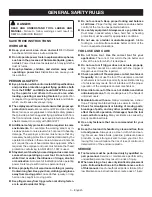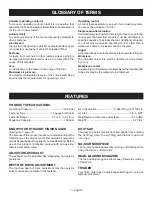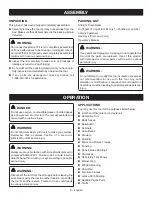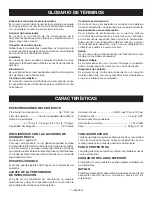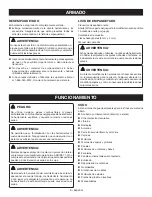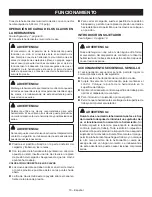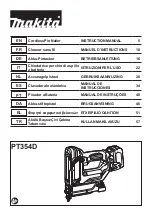
9 – English
WARNING:
Always wear eye protection. Eye protection does not fit all
operators in the same way. Make sure the eye protection
chosen has side shields or provides protection from flying
debris both from the front and sides.
PREPARING THE TOOL FOR USE
See Figure 2, page 15.
Under normal use conditions, the tool should be lubricated
before connecting the tool to an air supply. Add air tool oil
into the air fitting on the tool once daily with minimal use,
or twice a day with heavy use. Only a few drops of oil at a
time is necessary. Too much oil will only collect inside the
tool and will be noticeable in the exhaust cycle.
Before connecting the tool, check the air compressor gauge
to be sure it is functioning within the proper range of 70-
120 psi.
DUST CAP
See Figure 2, page 15.
The dust cap helps prevent dust and debris from entering
the air fitting. Cover the air fitting with the dust cap when
storing the tool.
NO-MAR NOSEPIECE
See Figure 3, page 15.
The no-mar nosepiece attached to the nose of the tool helps
prevent marring and denting when working with softer woods.
When requesting a replacement nosepiece, request part
number 079065001203.
WARNING:
Disconnect the tool from the air supply before removing
or replacing the no-mar nosepiece. Failure to do so could
result in serious personal injury.
The no-mar nosepiece can be removed by pulling it down and
away from the nose. To replace the no-mar nosepiece, fit it
into place over the nose and push up at the back to reseat.
ADJUSTING THE EXHAUST
See Figure 4, page 15.
The adjustable exhaust on the top cap of the tool allows
the operator to direct the exhaust according to operator
preference. To adjust, turn the exhaust cap until the exhaust
blows in the desired direction.
WARNING:
Disconnect the tool from the air supply before leaving the
work area, moving the tool to another location, or handing
the tool to another person. Failure to do so could result
in serious personal injury.
OPERATION
CONNECTING THE TOOL TO AN AIR SUPPLY
See Figure 5, page 16.
DANGER:
Do not use oxygen, combustible gases or bottled gases
as a power source for this tool. The tool will explode and
cause death or serious injury.
This tool is designed to operate on clean, dry compressed air
at regulated pressures between 70 and 120 psi. The correct
air pressure is the lowest pressure that will do the job.
NOTE:
Air pressure that is higher than 120 psi may damage
the tool.
The tool and air hose must have a hose coupling that allows
all pressure to be removed from the tool when the coupling
is disconnected.
WARNING:
Always use a coupling that discharges all the compressed
air in the tool at the time the fitting or hose coupling is
disconnected. Using a coupling that does not discharge
the compressed air could cause unintended operation
and serious personal injury.
WARNING:
Do not climb rigging or scaffolding while carrying a tool
that is connected to an air hose. Doing so could result in
serious personal injury.
Connect the tool to the air supply with a 1/4 in. female quick
connector.
LOADING THE TOOL WITH NAILS
See Figures 6 - 7, page 16.
Connect the tool to the air supply.
WARNING:
The tool’s driving mechanism may cycle when the tool
is first connected to the air supply. Always connect the
tool to the air supply before loading nails to prevent injury
from unintended cycling. Always make sure the tool’s
magazine is empty at the beginning of each work session,
before connecting to an air supply.
WARNING:
Keep the tool pointed away from yourself and others
when loading nails. Failure to do so could result in
possible serious personal injury.



